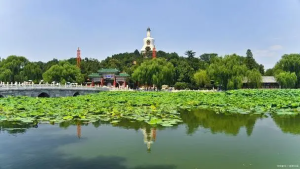History of Beihai Park
Beihai Park is located in the center of the capital Beijing, near the Palace Museum and Jingshan Park. Beihai Garden was founded in the sixth year of Jin Dading (1166 AD), with a history of more than 850 years, it is the oldest and best preserved imperial city garden in China, and it is also a representative of the garden construction pattern of “one pool and three mountains”. It is a collection of royal gardens, literati gardens, temple gardens, scenic spots, a comprehensive reflection of ancient Chinese garden art achievements, represents the highest level of Chinese classical royal gardens, with a unique style of garden art, is the essence of Chinese classical gardens and precious human cultural heritage.
Beihai Park covers an area of 68.2 hectares, including 38.9 hectares of water and 29.3 hectares of land. Here the water is open, the scenery is beautiful, the lake light tower shadow, pavilions, green pines and cypress, just like fairyland.

In the sixth year of Jin Dading (1166), King Shizong began to build Taeyong Palace in the eastern suburb of Zhongdu City (around today’s Beihai Park), which was completed in the nineteenth year of Jin Dading (1179), and built a large-scale and gorgeous palace, called “Taeyong Palace” (also known as “Wanning Palace”). Beihai Garden is an important part of Taining Palace. The overall layout of the garden adopts the regulation of classical royal gardens with one pond and three mountains. The earth mountain is built with the soil pile of digging Taiye pond, symbolizing Penglai, Yingzhou, Abbot and other immortal mountains.
Qionghua Island in the park is an important building and scenic spot, and many temples such as Guanghan Hall were built in previous years. The island is stacked with Taihu stone moved from the famous garden of the Northern Song Dynasty, and the scenery is pleasant, “Taiye autumn wind” and “Qiongdao Spring Yin” were listed as one of the “eight views of Yanjing” during the Jin Mingchang years.
From the Yuan Dynasty to the Yuan Dynasty, Kublai Khan built a new capital, Dadu. Qionghua Island and its lake were divided into the Great Imperial city and became the imperial Palace.
In the Ming Dynasty, Zhu Di, the emperor of Ming Chengzu, moved the capital to Beijing during the Yongle years. Beihai Garden became an important place for the Ming royal family to visit and study, and some ministers and scholars in the Ming Dynasty were also rewarded by the Ming Emperor, visiting the garden and leaving a lot of travel notes.
In the Qing Dynasty, the garden of Beihai was repaired and expanded on a large scale. Especially in the Qianlong period, the construction lasted for 38 years, which was huge in scale, long in construction period and countless in cost, which made the development of Beihai garden reach its heyday and laid the scale and pattern of Beihai Garden since then.
On August 1, 1925, Beihai Garden was opened to the public.
In 1961, The State Council announced Beihai and Tuancheng as the first batch of national key cultural relics protection units.
In 2001, it was approved by the National Tourism Administration as a 4A level advanced tourism unit.
In 2003, it was named “Boutique Park” in Beijing.
In 2011, the Central Spiritual Civilization Construction Steering Committee awarded Beihai Park the title of “National civilized Unit”.
In 2023, it was identified as the “second batch of national civilized tourism demonstration units”.